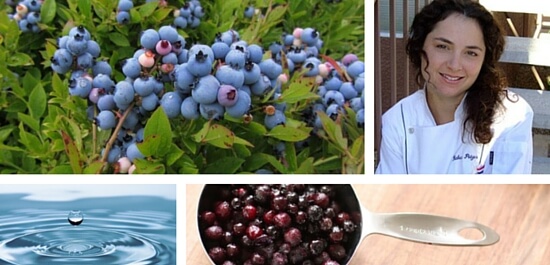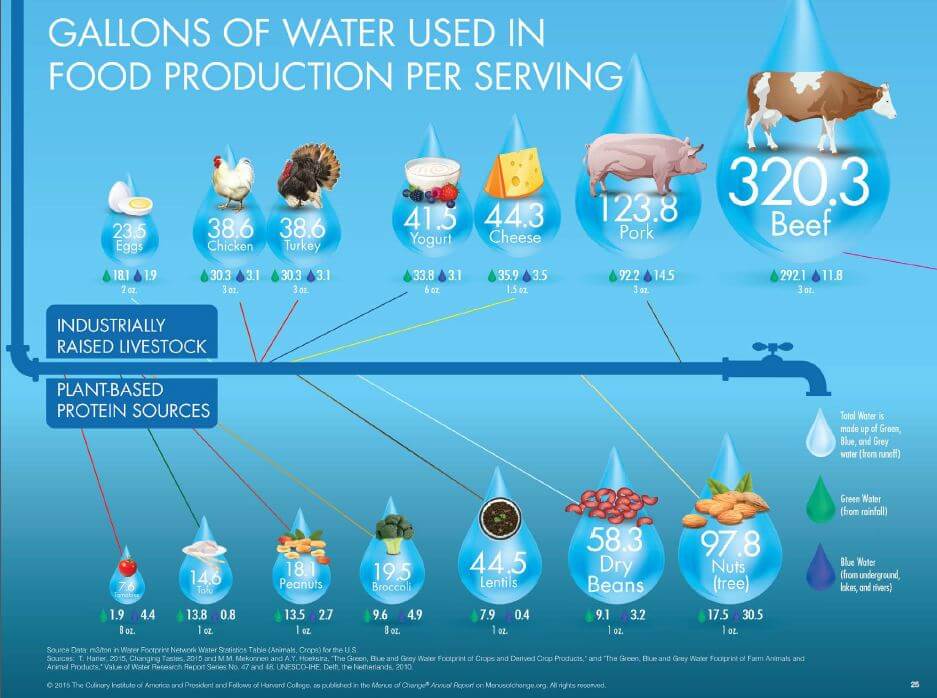How many gallons of water does it take to produce a pound of food? The answers will amaze you.
Back To Second Grade. Do you remember studying clouds in elementary school? Teachers loved showing us those charts of water evaporating from the sea, turning into clouds, falling as rain in the mountains, and running across the plains back to the sea. What they forgot to draw were the little human beings.

Water usage is one of the fastest-growing concerns in the eco-movement today, and what we choose to eat has a very large influence on what happens to water as it moves through its cycle. Every plant sown and every animal birthed for our dining pleasure impacts the planet’s resources through its own cycle of growing, processing, packaging, transporting, and preparing. Yet to those of us in the industrial world, food comes from a package rather than a sea, cloud, mountain, or plain. Small wonder that we tend to look at food through the narrow lens of our own sustenance or pleasure.
Craving a nacho chip? It takes almost 140 gallons of water to produce one pound of corn. Water is also needed to clean the processing equipment, produce the oil for frying, and make the packaging. How about a nice steak? If that pound of corn is used as cattle feed, additional water is required for cleaning and processing it. The corn needs to be transported to the feedlots, which uses gasoline, which takes three quarts of water to produce enough fuel to travel each mile. Each pound of beef we consume takes around 1,700 gallons of water to produce. Care for wine with dinner? Each grape requires about a third of a gallon to produce. A pound of tree nuts represents 1,565 gallons of water, a pound of pork 660 gallons, and a pound of cheese 473 gallons. These and other facts are available in the Menus of Change Annual Report.
Seven billion people will continue to need to eat, of course. But today’s sustainability movement takes many of its cues from natural systems to produce food that is economically, environmentally, and socially more responsible – and recognizes that humans are active participants through the choices we make. That’s one of the reasons that wild products are growing so quickly in popularity. They developed as part of a natural system, growing on their own accord year after year with little manipulation from humans.
Wild Blueberries emerged on the desolate plain (aptly named The Barrens) following the retreat of the glaciers and so were naturally selected to survive in nutrient and drought-challenged conditions. Today they continue to flourish in the humid climate of Maine and Eastern Canada where storm systems from the west and south converge to provide ample rainfall. The lowbush blueberry plants only require irrigation during dry spells – usually in August – when there is less than the required one-inch of rain each week.
According to David Bell of Cherryfield Foods, a harvester and packer of Wild Blueberries in Cherryfield, Maine, “Many fruits and vegetables are grown in locations that are too dry for natural survival, so much more irrigation water is needed for survival. In contrast, Wild Blueberries are irrigated supplementally to address short-term dry spells during the growing season.”
Bell also points out that the supplemental water is sourced from wells that were installed starting in the 1990s as an offshoot of another eco-project: restoring the Atlantic Salmon population living in the rivers where agricultural water was once sourced. The wells are replenished by rains in late fall and early spring and are placed away from the rivers for minimal impact.

© 2015 The Culinary Institute of America and President and Fellows of Harvard College, as published in the Menus of Change Annual Report. All rights reserved.
As part of their unique evolution, any given field of Wild Blueberries may have thousands of clones with an extensive underground rhizome system. Seventy to eighty percent of the plant actually lives under ground, spreading horizontally in the few inches of organic matter atop the sand and gravel of glacial soil below. This allows the plants to use every bit of surface water available while soaking rains travel onto the aquifer below. The Native American practice of burning the plants to the ground each year gave way to mowing (or pruning) of the plants to the height of a tall lawn. This pruning maximizes organic matter retention while reducing the atmospheric effects of the smoke.
Evolution also makes for great eating and good business. Wild-sourced foods grow in very specific places for very specific reasons, and as a result, they produce very specific flavors – described as terroir. Wild salmon returning to the Copper River in Alaska each year not only create a market frenzy, but they command a premium price. Pine nuts from the Southwest are prized for the same reason. The Wild Blueberry Barrens produce a small fruit with the most intense flavor burst and massive antioxidant levels. Now that’s reason to celebrate!